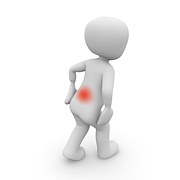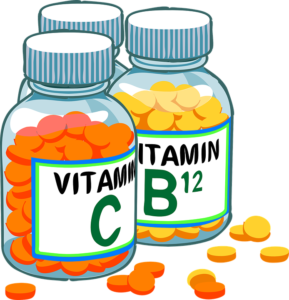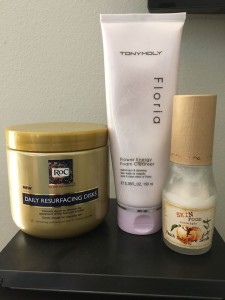
by drmiranda | Mar 21, 2018 | Uncategorized
We’ve had some requests for an “Ask Dr. Miranda” feature, so here is the first question we’ve been sent:

Q — I’m trying to lose weight and my biggest issue is my stomach. How do I get it down? Any suggestions?
A – – First, you are not alone! Many people tend to accumulate weight below the belly button far easier than above, it is inherent to our general fat distribution and certain hormones. In fact, very often abdominal weight isn’t just fat under the skin, but rather includes the more dangerous visceral fat that you’ve read about, so it is important to address. For the record, any male with a waist circumference of 40+ inches, or a female with 35+ inches, is considered to have dangerous levels of abdominal fat. So given that, there are several proven ways to target abdominal fat: Let’s take a minute to look at the major ones.
1) Kick sugar to the curb! Sugar in ALL of its incarnations, including High Fructose Corn Syrup (HCFS) is probably your number one trigger for abdominal fat. Now, remember, to your body, a carb is a carb to a great extent. White bread, potatoes, pasta, sodas, etc. all get broken down into glucose, and what you don’t immediately use up for energy expenditures, you store – and your gut is the numero uno place the body starts to store fat! I am going to go out there on a limb and say that added sugar in general is a no-no! It is unhealthy, and has strong, negative effects on your metabolism. Now, sugar is composed of half glucose and half fructose, it can ONLY be broken down in the liver in any significant quantity. So, if you are exposing your system to sugar daily, your liver gets overworked. Your pancreas gets overworked. Your body has no choice but to start storing as much as it can as fat. Listen up fruit eaters – you don’t get off scot-free, fruit contains a large percentage of fructose, and large amounts of fructose were never meant to be eaten by us. Most wild fruits are small and were only eaten in small amounts seasonally. Our ancestors rarely got the opportunity to chow down on a giant bowl of fruit salad every day for breakfast. Fructose is also directed into fat storage! That is why I have specific guidelines on how much fruit you should eat for optimal fat burning AND specific times you should eat it. Large amounts of fructose also tend to make the gut leaky, and cause digestive imbalances with your good bacteria, which leads to GI discomfort and the development of allergies. Very often, the health benefits of fruit are not outweighed by their sugar content. You have to really educate yourself and look at the difference between whole fruit (and its beneficial fiber content) and fruit derivatives, concentrates, and parts. Keeping this in mind, the top way most people intake sugar, is by drinking it. Don’t drink your calories is one of our important Lifestyle List tips for that very reason. If you audit your daily sugar intake – most people fall short here. Your brain doesn’t recognize liquid caloric intake in the same way it recognized calories that were chewed, and sugar-sweetened drinks are associated with a 60% increased risk of obesity. So, a simple solution is to just avoid it as much as possible. Now, if you are sitting there at home telling me you don’t drink soda – this also applies to sweetened teas, sports drinks, coffee drinks, and fruit juice.
- Count grams of protein, not calories! Protein is the best fuel for your metabolism, and getting in enough high quality grams of protein per day is absolutely crucial for optimal fat burning. No, this doesn’t mean that you need to eat an 18oz porterhouse steak 3 times a day, but you need to be cognizant of how much protein you are consuming. For most people, 80-100g per day is a good range to shoot for. If you are over 60 lbs overweight, you should be in the 100-120 g per day range. If you’ve followed me for any length of time, you know that I’m a huge advocate of protein for breakfast. it is my belief that having a high protein, low carb breakfast is the most important thing you can do for your metabolism and insulin levels. Your first meal of the day literally sets the stage for how your metabolism responds for the rest of the day – so make good choices. So, lets say you are trying to keep the 80-100 g of protein in mind, divide this up into the number of meals you consume daily to get your average per meal. Most people eat 3 meals per day, so if you aim for a protein intake of 30g per meal, you fall exactly in the middle of the range! Furthermore, protein provides key amino acids that reduce cravings by upwards fo 60%, and boost the amount of calories you burn by 80 or more calories per day. Studies have shown a link between the quality and quantity of protein consumes and a reduction of abdominal fat. People consuming enough grams of protein typically decrease their caloric intake by over 400 calories total per day, and if you’ve already lost your weight, eating enough protein helps you from putting the pounds back on — so it’s a win-win food choice!
- Tell carbs to take a hike ! Carb reduction is one of the most studied and most consistently successful ways to lose weight. Now, no one is saying ALL carbs are bad, because carbs found in whole vegetables are just fine, but the starchy, sugary carbs head straight for your midline. There are literally dozens of studies that show that low-carb diets lead to 2-3 times more weight loss than low-fat diets. Low carb diets are difficult for some people however because they are addicted to carbs and the serotonin rush they get from eating their comfort foods, so you have to either make drastic cuts or gradual cuts based on what suits your personality best. Low carb diet specifically target abdominal fat, so if you need to lose belly weight – cutting carbs is crucial. Men should look at keeping carbs below 50 g per day, women should aim for 45 g per day, however this number will vary. Some women tell me they have done low carb but a review of their food journals show they are still getting in 60-80g of carbs per day, and the weight doesn’t start falling off until they hit 40g. YMMV, but the above guidelines are a good place to start! And please – keep your servings of carbs for lunch and dinner – we want breakfast to have as few carbs as possible.
- Poop. Is one meal coming out for every meal that goes in? We have become the constipated generation. I guess it wouldn’t take much to convince you that your friends and coworkers are full of it! Unfortunately it is true – most people consume a Standard American Diet (SAD) and it is SAD — it is nutritionally devoid of protein, nutrients, and fiber. It is a hot mess. The result is that they estimate that ~70% of the population deals with regularity issues. To be blunt – for every meal that goes in, one should come out. If you eat 3 meals a day, you should be having 3 bowel movements per day. If you are not, that is your sign that you need to clean up your diet, add more fiber and fiber rich veggies, add magnesium, and drink more water. Now, many of you are familiar with fiber associated with grains, and while that can be true, fiber is indigestible plant matter. So, if you are reading a box of flax seed toasts – and it says 18 g of carbs per serving, 11 g of fiber. You can subtract the g of fiber from the total amount of carbs to get your NET carbs. In this case – 18g – 11g = 7 NET g carbs! That makes that piece of flax toast a lot healthier looking, doesn’t it? Now, not only does fiber help fill you up and satisfy certain cravings, but it keeps you full and satisfied longer. It helps to hold water in your bowel, so your stools are not dry little bullets that need chemical laxatives (or dynamite) to dislodge. One study showed that adding an additional 14 g of fiber per day to the diet increased weight loss by 4.5 lbs over 4 months doing nothing else! The best sources of fiber include seeds, vegetables, legumes, oats, etc. There are also plenty of fiber supplements on the market that make it relatively easy to increase your fiber intake without adding additional calories.
- If you want to lose it, you’ve got to move it! It has been often repeated that you cannot out-exercise a bad diet, and that is true, however that doesn’t negate the importance being active is to your overall health. There is no such thing as spot fat reduction when it comes to exercise – that is entirely a myth, but — when you consistently exercise, you lose weight from everywhere you’ve stored it, and since bellies often have a greater percentage of stored fat, you should notice fat loss there first. Aerobic exercise has long been found to reduce abdominal fat. It is also good for increasing your basic metabolic rate, reducing inflammation , normalizing blood glucose levels, and increasing energy levels.
- Write it down or it didn’t happen! One of the top predictors of whether people will be successful in losing weight is whether they are consistent about documenting everything they consume. Food journalers are typically FAR more successful at achieving and maintaining their weight goals. Most people will tell you they eat a good diet, but an inspection of their food journal will reveal otherwise! Many people have no clue of what they are truly consuming in the course of a day. Most over-estimate or underestimate what they are eating. Now, I love a plain old paper food journal, but tracking apps like MyFitness Pal are a wonderful addition to your program. Log everything, no matter how insignificant you think it is. You don’t have to do it forever, but until you achieve your weight goals – it is a good idea, and it is a barometer of your success. Food journalers find it easier to stick to their diet. They find it easier to turn down snacks and impulse food consumption. It is an easy way to hold yourself accountable.
- You’ve got to consume (healthy) fats in order to lose fat! Yep – that low-fat diet you’ve been told to follow is bad for your waist line. Your body is a fat-burning machine. Certain nutrients are fat soluble, and other faty are essential to your health, so when you avoid adding healthy fats to your diet, you create a deficiency state that leads to your body going into conservation mode – where it tries to hoard fat instead of burning it. Hoarding is bad – don’t be a hoarder – sneak small amounts of healthy fats into your meals. Not only do they help you assimilate more nutrients out of your diet, but they increase satiety, and are crucial for your health. If you have IBD or you are missing your gallbladder and fat digestion is difficult for you – use an appropriate digestive aid to facilitate the process.

by drmiranda | Aug 11, 2016 | diet, pain
 Chronic pain may be one of the most underestimated health issues there is, but many sufferers are only looking for a quick fix and an easy pill but that won’t buy them relief – it only postpones pain and further degeneration.
Chronic pain may be one of the most underestimated health issues there is, but many sufferers are only looking for a quick fix and an easy pill but that won’t buy them relief – it only postpones pain and further degeneration.
Now, if I were to categorize people with chronic pain – we can say that they often have an underlying autoimmune issue. They are commonly over weight – even as little as 10 lbs over their ideal weight can cause issues for them. They usually don’t have the best diet, and they frequently have a sweet tooth. Some don’t get out and move enough – they say the pain prevents them from doing so, but in medicine there is an adage — “move it or lose it”, and this is certainly true. You have to exercise to challenge your abilities, or you will lose the level of mobility that you currently have. It won’t get better if you do nothing!
So, if you have chronic pain, this is something that you may not want to hear – you need to clean up your diet. Diet alone can cause an 80% improvement.
80%! Did you catch that? Exercise is only 20% of the equation.
Chronic pain specialists have been putting their patients on low-glycemic diets for years, and there is a very good reason for this – sugar is highly inflammatory. Not only does it cause systemic inflammation, but it irritates every vein and artery in your body. It hyperirritates your muscles. Each tablespoon of sugar suppresses your immune system for 4-6 hours. In simple words – it feeds your pain.
But sadly, many people would rather keep their cheesecake and sodas than change their diet.
Let me be blunt – sugar in all its forms is inflammatory. It doesn’t matter if it is honey, agave syrup, corn syrup, molasses, fructose, dextrose, maple syrup, grape sugar… just because you think it is ‘natural’ that doesn’t mean it is not sugar!
Artificial sweeteners are no better – they are both excitatory and neurotoxins. They will make you feel worse!
So, what is a hurting person supposed to do? First off – cut the sugar. This will be the toughest thing I ask you do to because sugar is hidden in everything and you have to become a master of reading labels. Second, look at minimizing these foods from your diet : milk & dairy, soy, trans fats, beer, fried foods, night shade vegetables, and processed foods. If you are hypothyroid, consider a gluten-free diet as well. Limit caffeine to 1 serving per day. When you are highly inflamed, excess caffeine will irritate you!
What does this leave you to eat? Lots! Make dark leafy vegetables a key part of your meals. Cold water fish, raw nuts, avacados, sea vegetables, ginger, berries, cherries, turmeric, flax seed oil, olive oil, etc. should all become routine parts of your meals. Eat the rainbow! Eat at least 2-3 things raw every day! Take vitamin D supplements until your vitamin D level is between 50-75 nmol/L. All of these thing will have you feeling like a million bucks!

by drmiranda | Aug 11, 2016 | dietary supplements, hypothyroid, not losing weight
It’s been said tha t the road to hell is paved with good intentions, and that certainly applies to the world of dietary supplementation. Many people, through research or recommendation, choose to take a variety of dietary supplements to improve their health, but what many don’t realize is that supplements need to be taken the RIGHT way, or you will impair the absorption of them, or simply end up with very expensive urine.
t the road to hell is paved with good intentions, and that certainly applies to the world of dietary supplementation. Many people, through research or recommendation, choose to take a variety of dietary supplements to improve their health, but what many don’t realize is that supplements need to be taken the RIGHT way, or you will impair the absorption of them, or simply end up with very expensive urine.
Taking vitamins and herbal supplements together is usually not a problem but there are a few exceptions to keep in mind.
First, lets cover the basics:

The Best Time to Take Various Vitamins and Supplements
MEAL FRIENDLY
Traditionally, it is recommended that multivitamins formulas and water soluble vitamins – including the B-complex and vitamin C get taken with your meals for optimal absorption but in reality, they can be taken any time. However, fat soluble vitamins, such as vitamins A,D,E,& K – are best taken with a meal containing fats. The dietary fats enhance the absorption of the fat soluble nutrients. One small caveat, some people are sensitive to parts of the B-complex, and that can impair sleep. If this describes you, take your B-complex vitamins before 2 pm. The biggest mistake that people make with taking a multivitamin is taking it once a day. The body can only absorb so many nutrients at a time, so taking nutrients in divided doses will ensure you get the most from the products you buy.
Fatty nutrients, like fish oil, coconut oil, flax seed oil, borage oil, evening primrose oil, and even coQ10 also do best when taken with a meal containing fats. Fats always like fats – any time you take them together, you will get more benefits.
BEST ON EMPTY STOMACH
Certain nutrients require an acidic environment for optimal absorption. This usually means they do best when you haven’t diluted your stomach acid with food prior to taking them. Iron falls into this category. Iron is notorious for not only being difficult to absorb, but it can be highly irritating to your gastrointestinal tract. For this reason, it is commonly suggested that you take iron with vitamin C, which greatly enhances the amount your body can absorb, and take it with the least amount of food your stomach can handle without getting upset. But please keep in mind that iron does not like fiber or vitamin E. Either of these will bind together with the iron and you will negate their benefit. There are forms of iron that are less irritating than others as well – so please experiment with these to find one your body tolerates.
Minerals such as magnesium and calcium* always require strong stomach acid for absorption, therefore taking them on an empty stomach will facilitate absorption as well. I usually direct my patients and clients to take their minerals at bed time, since the transit time is slower, and you can get more out of them. Additionally, minerals like magnesium have a calmative effect – so taking them prior to bed can not only help you sleep better, but they can lubricate your joints and relieve muscle pain, so you wake fresher than you otherwise would. As a general rule, I do not typically recommend routine calcium supplementation unless there is a specific reason why it is indicated. Americans consume more calcium per capita than nearly any other country, yet we have one of the highest osteoporosis rates, so clearly calcium is not the issue. On the other hand, it is estimated that upwards of 80% of the population is deficient in magnesium, and other co-factors for bone health – so I would rather concentrate my efforts there. One thing to keep
Amino acid formulas also prefer acidic environments, so taking these supplements, which are often used in body building formulas, or individually for specific repair processes, on an empty stomach will ensure you get optimal absorption from them.
Joint products like glucosamine and chondroitin also require a highly acidic environment for absorption. While it may be inconvenient that you can’t take them with your meal, you will absorb up to 4X more from them by taking them alone.
Other than calcium, probiotics are perhaps the most controversial supplement on this list. It is my opinion that most recommendations for probiotic dosing are designed to promote probiotic sales, and it not what is required for optimal absorption. I always suggest taking probiotics before bed since most people do not get up in the middle of the night to have a bowel movement. This ensures that the probiotics have the greatest amount of contact time in the intestine, which therefore gives them the greatest chance to grow and colonize. If you were to take them with food, not only are you increasing the amount that would be killed by prolonged exposure to stomach acid, but rapid peristalsis that occurs with physical activity and as your meals progress down your alimentary canal during the day, means that they keep getting pushed along, and are not in contact with the optimal regions of the large intestine to do you much good.
BEFORE MEALS
Most commonly, digestive aids, enzymes, or other products should be taken at the beginning of a meal so that they may be thoroughly mixed with what you eat in your stomach. If you take it too late during your meal, most of your meal may have already passed into the small intestine, and it is simply too late to get the benefit of the product.
SPECIAL CONSIDERATION
If you have been diagnosed as being hypothyroid, you have likely already been directed to take your medication a minimum of 3-4 hours before any foods or supplements. If you have not received this advice, please speak to your doctor or pharmacist to confirm if you should be doing this with your particular brand of medication.
Antacids elicit a quandary. Many people take them (far more than should) so their meals do not upset their stomach, yet, by diminishing your stomach acid, you also diminish your absorption of vitamins and minerals in your diet. This frequently leads to osteopenia or osteoporosis and other health problems. If you are taking your supplements with meals and you take antacids or PPI’s, then you need to speak to your healthcare providers to see what you can do to optimize your absorption of healthy nutrients.
What you wash your supplements down with also makes a difference. Many medications and supplements interact with grapefruit juice, so please don’t use it to take pills of any form. That just plays it on the safe side. Green tea also interacts with a huge list of medications and supplements, so please avoid taking the two together. Milk can interfere with the absorption of a variety of nutrients, and therefore I do not recommend taking supplements with milk either. Even water can be problematic since some people tend to get reflux or their supplements will repeat on them if taken with plain old H20. So what can you take your supplements with — I recommend something lightly flavored, like diluted fruit juice or herbal teas. Even water with lemon.
Herbal supplements all very, so please follow the label instructions on them for optimal results.
So, as you can see, most supplements can be taken safely with your meals, and there are only a few exceptions to the rules. Knowing this, it becomes relative easy for you to divide up your supplements into a few you take with meals, and some on their own. Dietary supplementation need not be complicated. In my opinion, it is better to do something than nothing at all, and hopefully with this little guideline, it simplifies things enough so that you can use timing to get the most out of your health regimen.

by drmiranda | Mar 9, 2016 | diet, weight loss
Goldilocks and the three bears of exercise… Once upon a time Goldilocks went to a nice doctor in Louisiana because she had a serious muffin top and no matter what she did, she couldn’t budge it. Goldilocks told the nice Doctor, “I used to not exercise at all, and I got fat! But then, I started running marathons through the woods, and I still stayed fat! I exercise more than I ever have in my life, and nothing helps! Tell me Doctor, what can I do?”
The Doctor replied, “Well, Goldilocks, just like the best porridge is neither too hot nor too cold, the same goes for exercise. You do have to ‘move it to lose it’ but you don’t want to over-do it with sustained exercise. You see, exercise makes the muscles release a compound called IL-6. This IL-6 goes to your brain and signals it to tone down your hunger. It goes to your liver and tells it to balance out your blood sugar fluctuations better. It goes to your fat cells and tells them to burn more fat. But life is not all comfy begs and toasty porridge. There are two key types of exercise – A) Sustained duration exercise, like your running through the woods, and B) short duration, high intensity exercise. Like those 5-10 minute microburst sessions where you have to get away from those scary bears!. Long periods of exercise induce chemical reactions which negate the benefits of IL-6, and they increase stress hormones, like cortisol, which can make it much, much harder to burn fat. It is the short microburst activity, like High Intensity Interval Training (HIIT) or weight training, that shuts down the production of the inflammatory compounds and aging compounds your fat cells produce . They also elevate your metabolic rate, and even stimulate your thyroid health. HIIT is MUCH better than sustained exercise if your goal is to burn fat! So Goldilocks, we need to find the ‘just right’ level of exercise for your body. This means when you exercise, you are going to give it your all for very short periods of time, 45 seconds! then work slowly for a minute, then do another 45 second burst of intense activity. Do this 5-10 times, so you end up doing 10-15 minutes of physical activity, and do this once a day. You can do this twice a day if you really want to. This will make your body burn fat for hours and hours! Bye-bye muffin top, hello skinny lederhosen!”

by drmiranda | Jan 19, 2016 | skin care
Acne sucks. Yes, I said it! 
As someone who has had uber fair, oily, sensitive skin my entire life, acne was something I battled with from the age of 11 onward. I was so self conscious of my skin that I didn’t get in any baby photos after the birth of some of my children. I saw numerous doctors and dermatologists over the years for it, but nothing *really* seemed to work for me. So, I experimented with every new product or diet on the market for more years than I care to admit to. I FINALLY found a winning combination however, and I am happy to share it with you.
Cystic / hormonal acne can be deep, painful, red, and it can even scar. It does have a genetic component, so if either parent had it, you are more likely to have it yourself. Hormones certainly exacerbate it, and are the leading trigger for many people. In fact, many teenage girls are put onto birth control pills under the auspices of [hopefully] controlling their acne. There are dietary triggers, and food allergies certainly play a role, however both contribute to inflammation – which also makes acne worse. So barring getting hundreds of dollars worth of food allergy tests (although I do recommend those), I am going to cover what you can do at home, today, to turn your skin around but before I do, I would be remiss without mentioning conventional treatments. People with cystic /hormonal acne commonly have overactive sebaceous glands, and they may also have bacterial overgrowth or imbalances on the skin.
Conventional treatments typically include antibiotics, steroid injections, medications such as retinols or Accutane®, hormonal birth control pills, and various other topical preparations. All of these have their own associated potential side effects, the most common ones are photo-sensitivity, headaches, dry eyes and mouth, gastrointestinal issues, peeling or painful skin, depression, allergies, yeast overgrowth, muscle pain, and infection. Hormone based birth control also has additional side effects which you should discuss with your prescribing physician.
So, what can you do about it? The answer is a lot, actually. Let’s start with diet; it needs to be cleaned up. Eliminate as many processed foods as possible. The biggest allergen that I have found in my office is dairy. Eliminate it for 1 month and see how the skin does. It takes at least a month of ZERO dairy (no cheating!) to really get a good idea if dairy is your issue. Remember though, dairy is hidden in a lot of foods, and some people are horrible at avoiding it (ahem, teenagers, I am calling you out on this!). I suggest increasing your intake of fresh fruits and vegetables, and adding fresh lemon to your drinking water. Using neem soap, and applying a mask of raw honey or a probiotic paste once a week for 20 minutes can improve the skin ecology by reducing bad bacteria.
My skin improved with all of these things, but it never totally turned around until I stumbled on the following trifecta. I will preface this by saying that I have a much deserved reputation for finding odd-ball products that no one has ever heard of. I certainly love to experiment, and I LOVE Asian and Korean skin care products. I have read industry reports that they are typically 10 years ahead of the curve as compared to American skin care, and I believe it. I have rarely been disappointed with any of my Asian skincare or cosmetic purchases.
My daily routine is very simple: First, I use Tony Moly Floria Cleanser . It is an opaque white cream and you literally use less than a centimeter of it because it is so heavily concentrated. One bottle lasts me approx. 10 months with daily use. Second, I apply two pumps worth of Skin Food’s Peach Sake Pore Serum. It is a product designed to reduce oil production in the skin, and a bottle lasts 45 +/- days for me. I apply my make up over it once it dries. Now twice a week, I use Roc Resurfacing Disks on my skin before bed. This helps to eliminate all of the debris that accumulates on the skin over the course of the week. I’m frugal – so I cut them in half, therefore, a tub of 28 lasts a LONG time! That’s it! As you can see from my candid, unfiltered photo, my skin is the best it has ever looked, and I think it looks pretty good for being 40. My daughter, who also struggles with acne, follows my regimen now, and you can see her teenage skin has done well with the system too. In fact, as I worked on perfecting this over the past year, I have recommended it to several of my clients, and they have all reported massive massive improvements with it.
So, if acne is something you struggle with, and you have tried everything else, give this a shot. All three items are priced at $11 or less including shipping, and some last a very long time. I can say easily say that it has been the hands-down best skincare system I have found thus far.
*Clicking on the BLUE names of the Products above will take you to their sales page on amazon. These are not sponsored links. I receive no compensation for recommending them to you.
** Whenever you start a new skin care regimen, your skin can initially break out as the acne ‘brewing’ in various stages within the skin needs to come out. This is temporary and is to be expected. As always, please seek the counsel of your physician if you have any issues or concerns.








